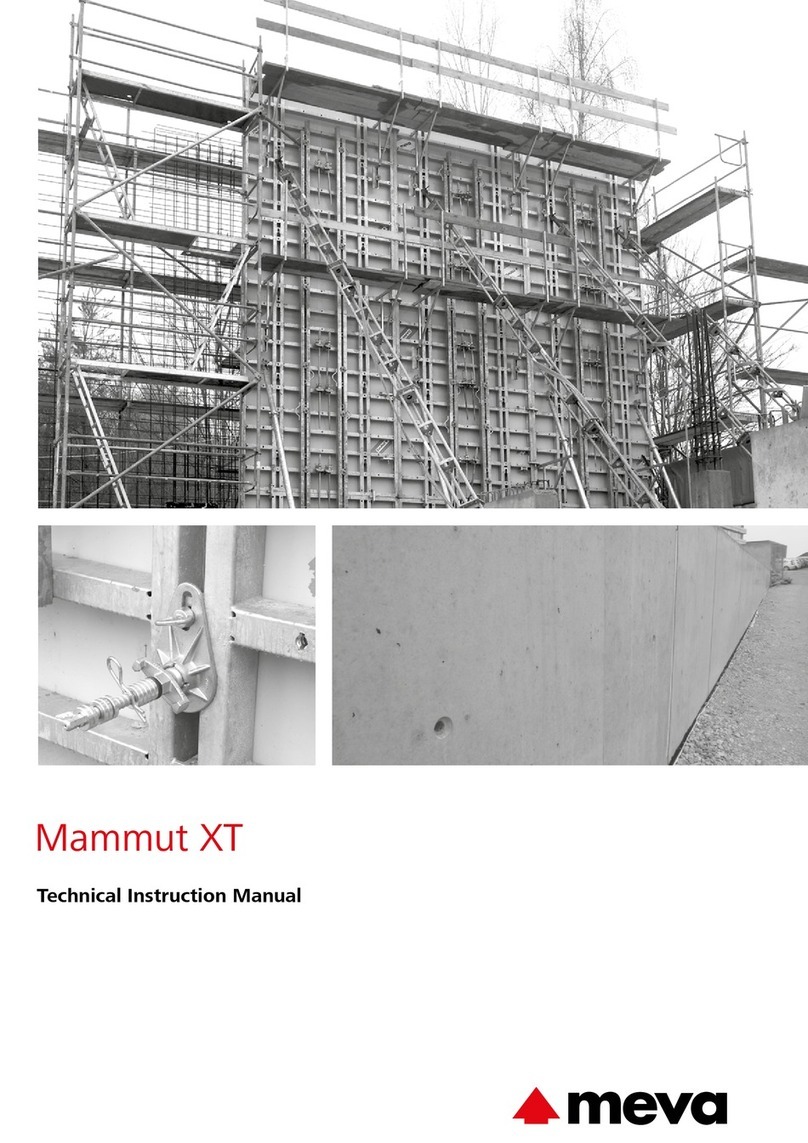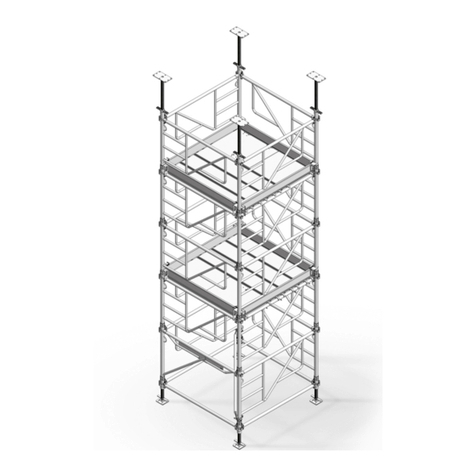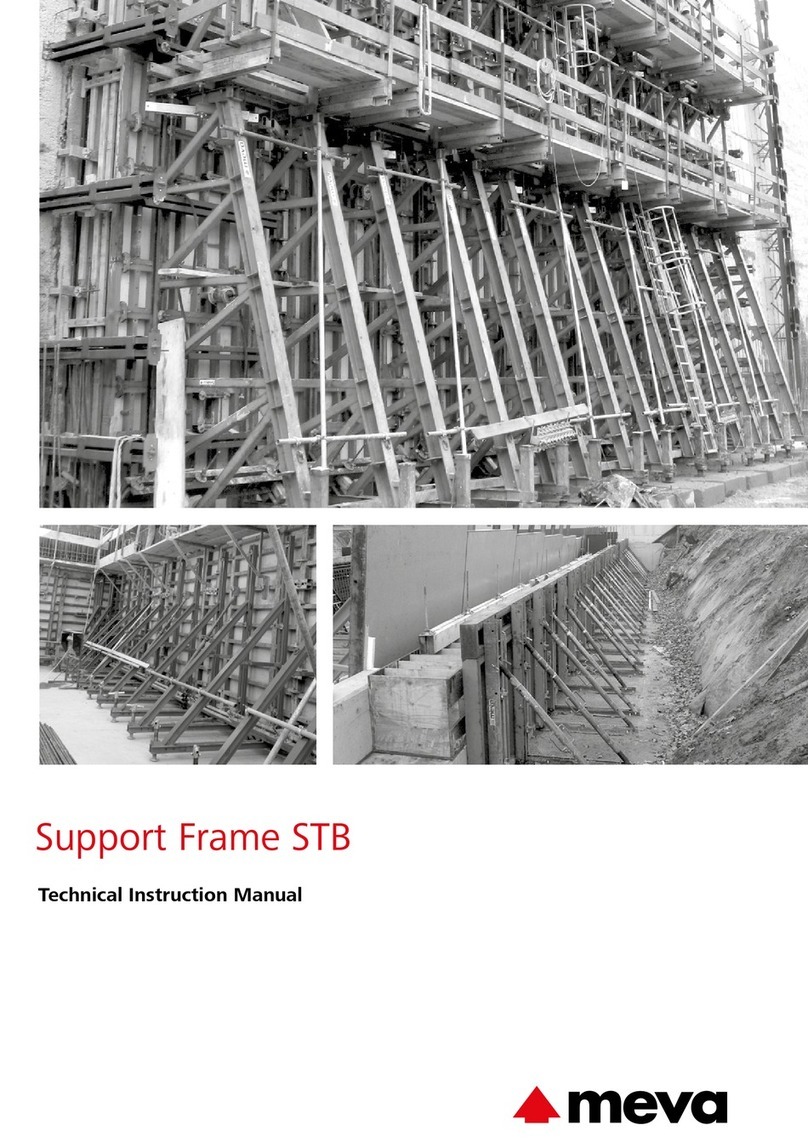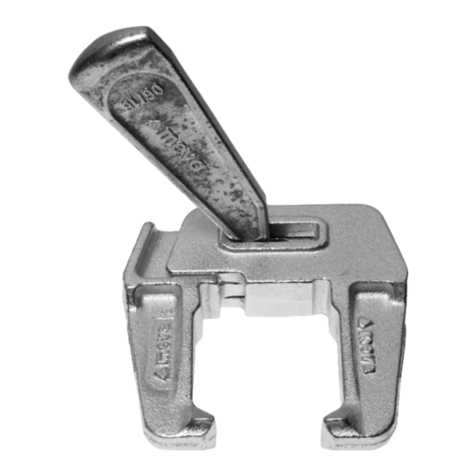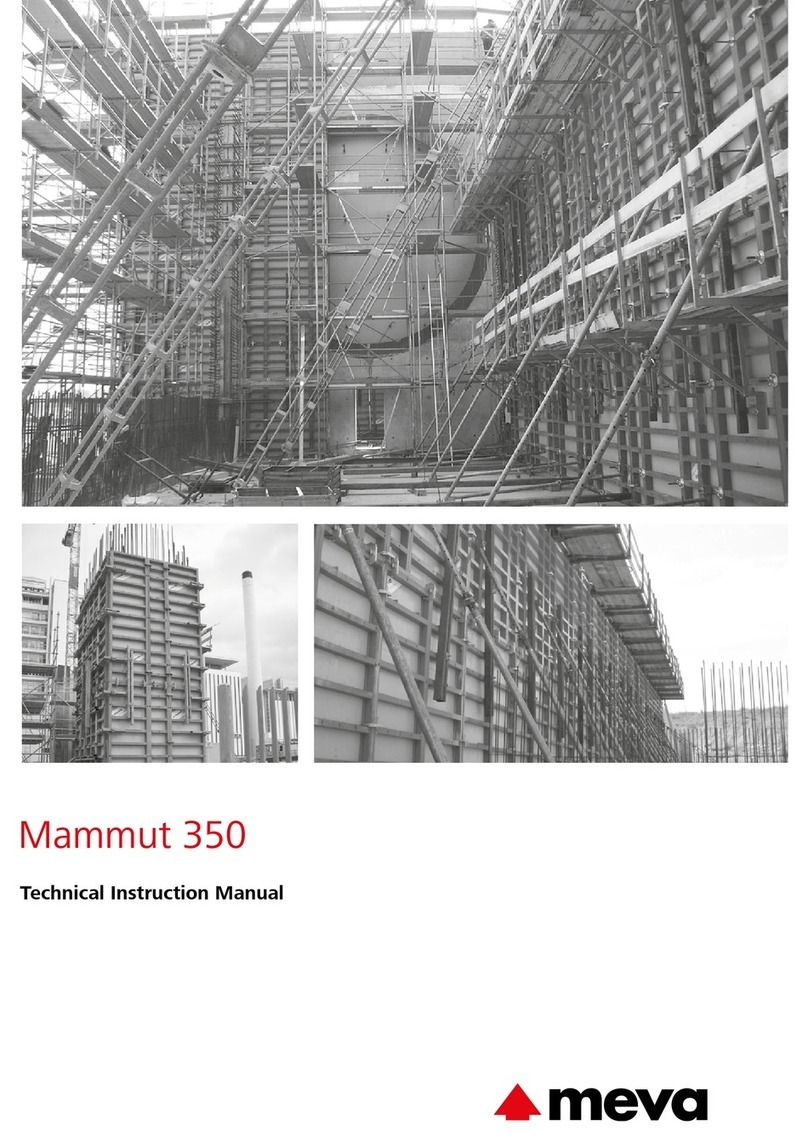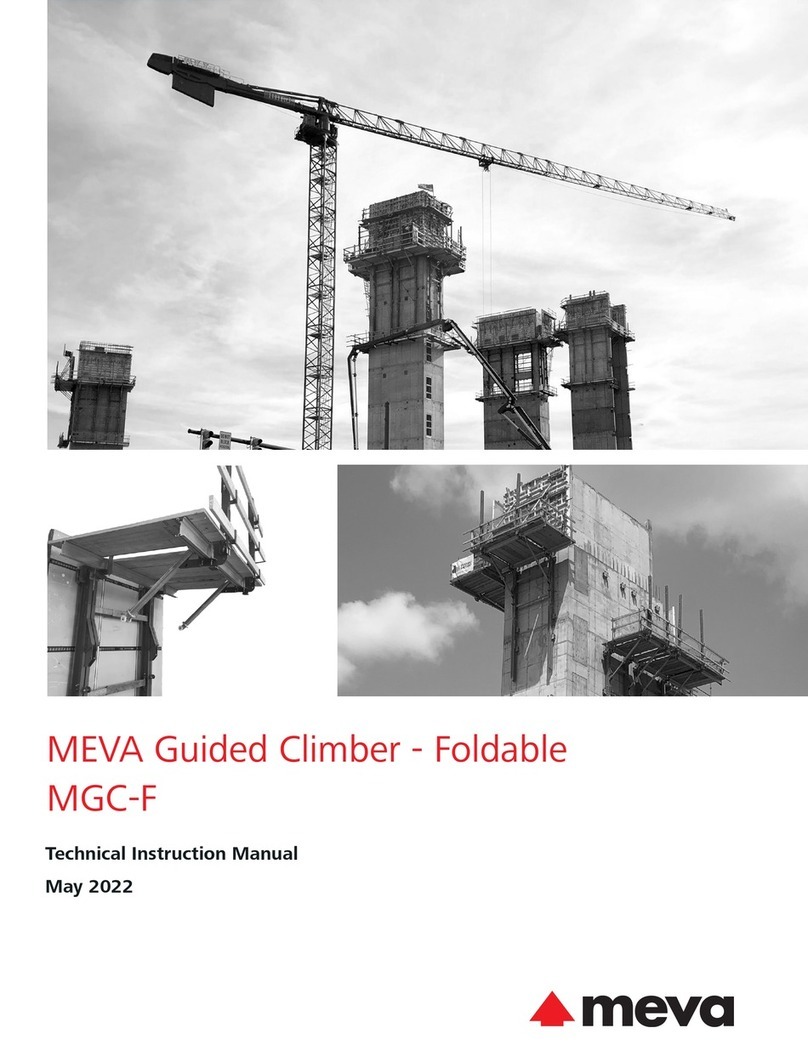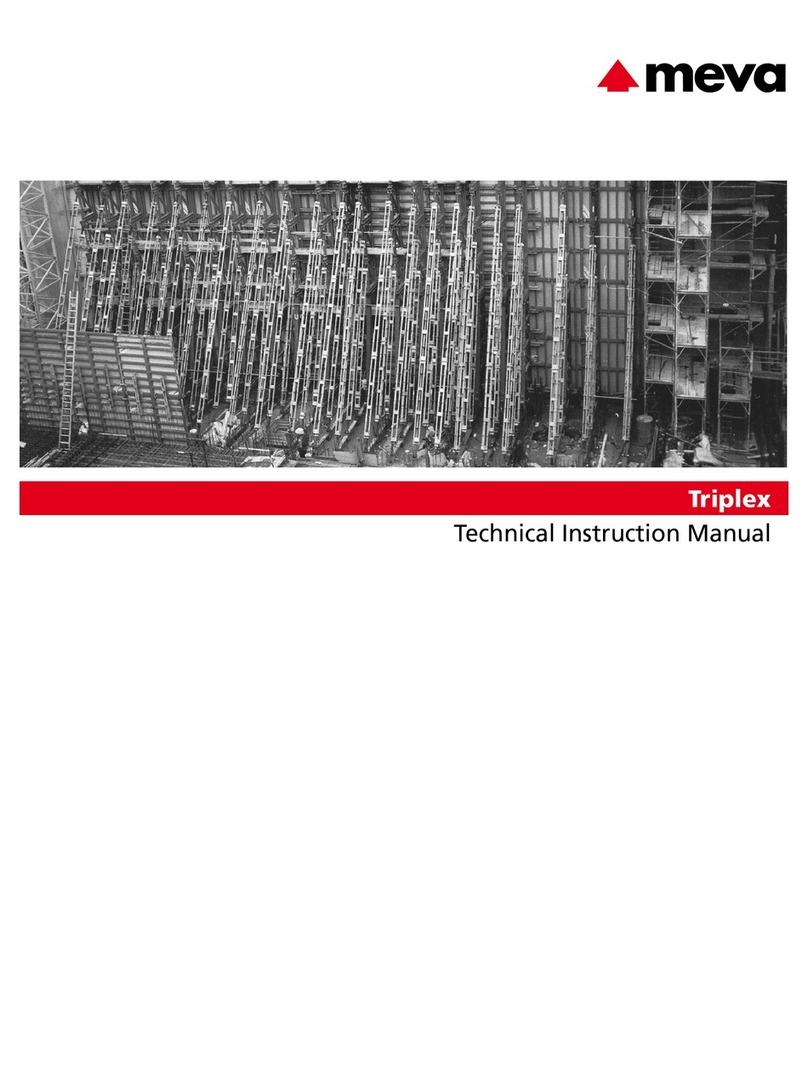Meva Mammut 350 Owner's manual

Technical Instruction Manual
Mammut 350

The Mammut 350 wall formwork is a crane-dependent formwork
system made of steel. It is ideally suited for use in high-rise, public,
commercial and industrial construction as well as civil engineering
projects that require a top architectural concrete surface.
The Mammut 350 has the following characteristics:
ÆSeven multi-function profiles
ÆTie holes at multi-function profile level
ÆBump notches for panels that are 250 and 125 cm wide
ÆSymmetry on the inside and outside
ÆAn even tie hole and joint pattern
ÆCompatible with Mammut XT and Mammut
ÆSame accessories used for Mammut XT, Mammut 350 and
Mammut
The steel frames of the Mammut350 panels are hot-dip galvanised
both internally and externally and post-treated. This ensures improved
corrosion protection, making them durable and easy to clean.
Mammut 350 panels are available with heights 350, 300, 250 and
125cm. A complete formwork set including accessories weighs
approx. 62 kg/m²
The MEVA multi-function profile with welded-in DW-threaded nuts
makes the attachment of accessories easier, for example:
ÆPush-pull props and alignment rails with flange screws
ÆWalkway brackets with integrated self-locking pin
ÆDW tie rods of any length that are used to bridge problem areas.
The Mammut350 panels are equipped with the 20 mm thick alkus
all-plastic facing made of polypropylene and aluminium. The facing
is riveted to the panel on the pouring side. In addition, the facings
are protected with silicone. The tried-and-tested polypropylene and
aluminium composite facing has all the positive properties of plywood
plus important advantages: longer lifespan, greater load-bearing
capacity, better nail-holding ability, fewer and easier repairs, 100%
recyclability.
Product features
The admissible fresh-concrete pressure is 100 kN/m² if DW20 tie
rods with a permissible working load of 160 kN are used (required for
panel widths from 100cm upwards). This high load capacity results in
short pouring cycles, since walls up to a pouring height of 400cm can
be poured without considering the rate of placing. The fresh-concrete
pressure for vertical formwork according to DIN18218:2010-01
can be determined easily and precisely with MEVA’s online concrete
pressure calculator. This and other digital aids are available in the
download area at www.meva.net and in the app MEVAme for iOS
and Android.
Abbreviations, measurements, figures and tables, etc.
The abbreviation M 350 is used for the Mammut 350 system series
and the abbreviation M for the Mammut system series. DIN means
Deutsche Industrie-Norm (German Industrial Standard). E DIN
(E=Entwurf / draft) means that the DIN is in draft status and not yet
approved. Any further abbreviations are explained where they are
used for the first time.
TÜV means Technischer Überwachungsverein. This is the independent
German organisation that tests the safety of technical installations,
machinery and motor vehicles. If a product passes the test, it is
permitted to carry the GS seal. GS stands for Geprüfte Sicherheit
(approved safety).
Measurements: This manual uses the metric system, i.e. m (for metre),
cm (for centimetre) and mm (for millimetre).
Non-defined dimensions are in cm.
The page numbers in this manual start with M350. The figures and
tables are numbered per page. Depending on its product abbreviation,
a cross reference in the text refers to a page, table or figure in this or
in another manual. This is indicated by the product code with which
the cross-reference begins.
M350-2 Technical Instruction Manual / Status November 2021
Mammut 350Wall Formwork

Please note
Contents
Formwork assembly and stripping..................................................... 4
The Mammut 350 panel ................................................................... 8
alkus all-plastic facing..................................................................... 10
Panel connection ............................................................................ 11
Tie holes......................................................................................... 12
Rules for concrete pouring and rate of placing................................ 13
Flatness of surface .......................................................................... 14
Attachment of accessories .............................................................. 15
Wall braces..................................................................................... 16
Working scaffolds – Folding access platform BKB 125..................... 19
Working scaffolds / walkway brackets ............................................ 20
Working scaffold – Ladder fixture for wall formwork ...................... 21
Working scaffolds – Tilting bracket 40/60....................................... 22
Crane Hook .................................................................................... 23
Inside corner 90° ............................................................................ 24
Outside corner 90° ......................................................................... 25
Height-extended 90° outside corner ............................................... 26
90° corner with filler....................................................................... 27
90° corner – Combinations ............................................................. 28
Hinged corners ............................................................................... 29
Stripping corner.............................................................................. 31
Stripping panel – For stripping support of short walls ..................... 39
Length compensation ..................................................................... 40
T wall connection ........................................................................... 42
Connection to existing walls ........................................................... 43
Stop ends ....................................................................................... 44
Wall offset...................................................................................... 46
Pilasters .......................................................................................... 47
Differences in height....................................................................... 48
Horizontal panels............................................................................ 49
Substitution of ties.......................................................................... 51
Height extension............................................................................. 53
Crane ganging................................................................................ 55
Column formwork – With standard panels and outside corners ...... 57
Column formwork / column panel .................................................. 58
Panel with filling nozzle / concreting window.................................. 64
Single-sided formwork / climbing formwork ................................... 65
Lifting hook 60 .............................................................................. 66
Transport ........................................................................................ 67
Services .......................................................................................... 68
Product list ..................................................................................... 71
This Technical Instruction Manual contains information, instructions
and tips that describe how to use the MEVA equipment on the
construction site in a proper, quick and economic way. Most examples
shown are standard applications that will occur in practice most
often. For more complicated or special applications not covered in this
manual, please contact the MEVA experts for advice. They will help
you without delay.
When using our products, the federal, state and local occupational
health and safety regulations must be observed. Please observe the
assembly instructions that your local contractor or employer has
created for the site on which the MEVA equipment is used. Such
instructions are intended to minimise site-specific risks and must
contain the following details:
ÆThe order in which all working steps including assembly and
disassembly must be carried out
ÆThe weight of the panels and other system parts
ÆThe type and number of ties and braces as well as the distance
between them
ÆThe location, number and dimensions of working scaffolds
including the working area and fall protection equipment required
ÆAttachment points for panel transport by crane. With regard to
panel transport, please observe this manual. Any deviation will require
structural verification.
Important: Generally, only well-maintained material may be used.
Damaged parts must be replaced. Use only original MEVA spare parts
for replacement.
Attention: Never wax or oil assembly locks!
M350-3Technical Instruction Manual / Status November 2021
Mammut 350Wall Formwork

Formwork assembly and stripping
Fig. 4.1 Double-sided formwork
Important!
When assembling and stripping
formwork, strictly observe the
local accident prevention rules.
When using our formwork and
systems always observe federal,
state and local codes and
regulations.
Attention
Above a formwork height
of 2.00 m both sides of the
formwork must be secured
against falling.
Planning
If you want to benefit fully from
the ecient and economical
use that the formwork offers,
we recommend you first plan
and prepare its use. Start
planning by determining the
optimum formwork quantity to
be held in stock (the quantity
is usually based on the amount
of formwork required for a one
day‘s work). When determining
the quantity, consider the
following:
ÆThe formwork weight
ÆThe time required for
formwork assembly and stripping
ÆTransport of gangs from one
pour to the next considerably
reduces assembly and stripping
effort and time
ÆCapacity of the lifting devices
ÆA logical cycle plan that
takes into account corner
configurations, reinforcements,
etc.
Once all these aspects have been
considered, the quantities of
formwork items can be specified.
Ground
The ground on which the
formwork is going to be placed
should be clean, even and
capable of bearing the expected
load, as this will help reduce the
time required for the assembly
and stripping.
Panel transport
When unloading panels or
moving panel stacks, make sure
to use appropriate transport
devices that can bear the load.
For detailed information see page
M350-66
The steps required for
assembly
For ergonomic reasons the
outside formwork is usually
assembled and placed first. Start
assembly in a corner or at a
defined position and perform the
following steps:
Step 1 – Place and brace the
outside formwork
Step 2 – Define and mark the
pouring height, install the
reinforcements and boxouts
Step 3 – Place the inside
formwork and tie the outside and
inside formwork
Refer to the following pages for
a detailed description of these
steps including the installation
of the working platform and
formwork stripping.
M350-4 Technical Instruction Manual / Status November 2021
Mammut 350Wall Formwork

Fig. 5.1
Formwork assembly and stripping
If the walkway bracket was not
pre-assembled before step 1, you
can now assemble and install the
working platform. Fig.6.2
on page M350-6 shows a
working platform being lifted
with a crane for attachment to a
braced outside formwork.
3. String further panels together
and connect them with M
assembly locks (see page
M350-11).
Panels with a height of 350cm
are usually connected with three
assembly locks. However, outside
corner configurations require
four assembly locks (Fig.5.2).
Step 2
Pouring height,
reinforcements and boxouts
After performing step 1, the
pouring height is defined and
marked. Then the reinforcements
and boxouts, if required, are
installed.
Step 3
Place the inside formwork
and tie the outside and inside
formwork
The inside formwork is placed
after the outside formwork. Then
the inside and outside formwork
are tied firmly with tie rods and
articulated flange nuts.
Step 1
Place and brace the outside
formwork
The following description is
based on an straight wall. Before
starting, keep in mind:
ÆWhen pre-assembling large
panel units on an even surface,
attach the wall braces and the
walkway bracket as well, i.e.
before performing step 1.
ÆWalls of less than 6m require
a filler in the inside formwork
for easy stripping (Fig. 5.3), as
the formwork may otherwise
become wedged and stick to the
concrete when it is stripped.
1. Spray the facing with the
release agent MevaTrenn pro.
2. Place the first panel and
immediately attach it to the
ground or concrete slab with
two brace frames to prevent it
falling over (Fig. 5.1). The foot
plate must be firmly connected
to the ground or concrete slab –
in earth with two ground pegs,
in concrete with two heavy-duty
dowels.
After placing vertical panels,
always reinforce them
immediately with push-pull
props or brace frames so they
can withstand tensile and
compressive forces and are
protected against displacement
and wind. The prop spacing is
determined by the application.
Fig. 5.2
Fig. 5.3
Filler for easy stripping
M350-5Technical Instruction Manual / Status November 2021
Mammut 350Wall Formwork

Formwork assembly and stripping
Working scaffold
The plug-in walkway bracket
(Fig. 6.1) is used to support the
working scaffold. The maximum
bracket spacing for a load of
150kg/m² (platform group 2) is
2.50m as defined in DIN 4420.
The planking must be at least
4.5cm thick.
The planking and walkway
bracket can be firmly connected.
Do not install any planks before
securing the formwork with
push-pull props or before tying
the inside and the outside
formwork.
Do not forget to attach a side
railing to the working scaffold.
Pouring concrete
Once you have placed, tied,
braced and closed the formwork,
you can start pouring concrete.
When doing so, observe the
permissible rate of placing taking
the setting behaviour and the
consistency of the cement into
account (see page M350-13).
Fig. 6.1
Fig. 6.2
M350-6 Technical Instruction Manual / Status November 2021
Mammut 350Wall Formwork

Fig. 7.1
Fig. 7.2
Formwork assembly and stripping
Stripping
Do not start stripping before the
concrete has set to the point
where it can no longer deform.
It is best to start stripping at the
stop ends or at a short corner.
Start stripping with the inside
formwork. Stripping of both the
outside and inside formwork is
performed as follows:
1. Remove the working scaffold.
2. Remove the articulated flange
nuts and tie rods section by
section. Make sure the unbraced
formwork is immediately secured
to prevent it falling over or strip
it immediately.
3. On the formwork panels or
large panel units the assembly
locks are removed at the joints,
and the panels or panel units
are then lifted out by hand or
by crane. Before transporting by
crane, the formwork must be
detached from the concrete!
4. Clean the facing and remove
any concrete. Before the next
use, spray the facing with the
release agent MevaTrenn FT8
(for alkus facings). Observe the
operating instructions for the
alkus facing.
Note
The release agent must not be
stored in galvanized containers.
Please note
When stripping manually, detach
and disassemble the working
scaffold and the brace frames
before stripping the panels.
When transporting large panel
units with a crane, the working
scaffold and wall braces are
moved together with the
panel units. While vertical, all
components are cleaned and
sprayed with release agent
before being lifted together
to the next cycle (see pages
M350-55 and 56).
If there is no further use for the
panel units, the working scaffold
and wall braces are detached
and disassembled in a horizontal
position, and cleaned and
stacked for transport.
M350-7Technical Instruction Manual / Status November 2021
Mammut 350Wall Formwork

Fig. 8.1
Tie hole with conical anchor
sleeve (see page M350-12).
Fig. 8.2
Panel connection with
the M assembly lock (see
page M350-11).
Fig. 8.3
Cross stiffener made of sturdy
closed steel profile.
Fig. 8.4
Quick and secure attachment
of accessories using welded-in
DW 15 threaded nuts (see page
M350-15).
Fig. 8.5
Transport hole to attach the
crane slings 60, allowing fast
loading and unloading of panel
stacks and enabling them to be
moved at ground or slab level
(see pages M350-66 and
-66).
Fig. 8.6
The steel frames are made of
closed hollow profiles with
welded-in mitred joints. The
profiles are provided with a
groove and edge protection.
Panels with a width of 125
and 250 cm are equipped with
four bump notches that are
diagonally welded in, allowing
exact panel positioning without
a hammer.
Note
For a list of the available panels
including their designations and
reference numbers refer to the
Product List.
The Mammut 350 panel
Fig. 8.1
Fig. 8.2
Fig. 8.3
Fig. 8.4
Fig. 8.5
Fig. 8.6
M350-8 Technical Instruction Manual / Status November 2021
Mammut 350Wall Formwork

The Mammut 350 panel
The large-size panels 350/250
(Fig.9.1) and 300/250
(Fig.9.2)
These panels are ideally suited
for vertical and horizontal use.
Since the tie holes are located
inside the panel, the 8.75m²
forming area of the 350/250
panel requires only six ties and
the 7.50m² forming area of the
300/250 panel only four ties.
The panels can be connected to
existing walls without alignment
rails or fillers. They can overlap
by up to 50cm (see page
M350-43).
If 250cm high panels are used
horizontally and mounted on
top of each other, an even joint
pattern with continuous vertical
joints is assured.
Vertical and horizontal panels
can be combined freely.
Panels with a width of 125 and
250 cm are equipped with four
bump notches that are diagonally
welded in, allowing exact panel
positioning without a hammer.
The panels can be positioned in
all directions without a hammer
(M350 Fig.8.6).
Description Ref. No.
M 350 panel AL 20
350/250 ................................ 23-005-05
300/250 ................................ 23-006-05
Fig. 9.2
Fig. 9.1
M350-9Technical Instruction Manual / Status November 2021
Mammut 350Wall Formwork

alkus all-plastic facing
The tried-and-tested
polypropylene and aluminium
composite facing (Fig.10.3)
has all the positive properties
of plywood plus important
advantages: longer lifespan,
greater load-bearing capacity,
better nail-holding ability,
fewer and easier repairs, 100%
recyclability.
Besides the obvious advantages
such as considerably reduced
cleaning effort, minimum
consumption of release agent
and an excellent, uniform
concrete finish, alkus offers
substantial ecological benefits.
Substituting plastic for wood
saves valuable timber resources.
Also, alkus avoids the release
of highly toxic dioxin that is
released when burning plywood
bonded with phenolic resin.
Used or damaged alkus facings
can be recycled to produce
new facings. They are 100%
recyclable and subject to a global
return policy.
Fig. 10.1 Frame profile with plywood facing:
Negative imprint in the concrete when using
panels with a conventional plywood facing
Fig. 10.2 Frame profile with alkus facing:
Smooth and even concrete surface as there are no
projecting profiles
Fig. 10.3 Design of the alkus all-plastic facing
Plastic layer
Metal or fibres
Foamed plastic core
Metal or fibres
Plastic layer
M350-10 Technical Instruction Manual / Status November 2021
Mammut 350Wall Formwork

Fast and ecient connection
of the panels is accomplished
with the M assembly lock
(Fig.11.1) whether the panels
are assembled side by side or
on top of each other (height-
extended). The assembly lock can
be attached at any position on
the panel joint between the cross
stiffeners. Since it weighs only
3kg, it can be easily attached
with only one hand.
Its 5-point contact (Figures11.2
and 11.3) draws the panels
together and aligns them.
Secure connection and perfect
alignment are achieved with
only a few hammer blows. The
assembly lock locks into a fail-
safe position immediately and
automatically.
Panels up to a height of 300cm
are connected with two assembly
locks and panels with a height of
350cm are connected with three
assembly locks.
When pouring walls in SB3
quality (German architectural
concrete class for immaculate
architectural concrete surfaces),
the use of an additional assembly
lock is recommended to connect
panels that are 250cm high or
higher.
Horizontal panel connections
generally require two assembly
locks.
For the quantity of assembly
locks required for outside corners
and columns refer to pages
M350-25 and -26 as well as
M350-57.
Panel connection
Fig. 11.1
Fig. 11.2 Fig. 11.3
= 5-point contact
Description Ref. No.
M assembly lock 29-400-71
M350-11Technical Instruction Manual / Status November 2021
Mammut 350Wall Formwork

Tie holes
The conical anchor sleeve
(Fig.12.1) for DW 15 and DW 20
tie rods is welded to the frame.
The M350 formwork can be
inclined up to 8 cm/m with
DW15 tie rods or 5 cm/m with
DW 20 tie rods (Figures 12.2 and
12.3). Inclined panels require
articulated flange nuts and
must be secured against uplift.
Articulated flange nuts 15/120
are used for DW15 tie rods,
articulated flange nuts 20/140
for DW20 tie rods.
Use a hammer or 27 mm spanner
(Fig.124) to handle articulated
flange nuts 15/120 without
damaging them and a hammer
or 36 mm spanner for articulated
flange nuts 20/140.
When connecting panels with
different widths, always anchor
them through the wider panel
(Fig. 12.6).
All usable tie holes must be
used for tying and non-usable
ones must be closed with plug
D27/30.
Panels can also be tied outside
the panel using a Uni-tie claw
(Fig.12.5).
Description Ref. No.
Tie rod DW 15/90.................. 29-900-80
Tie rod DW 20/120................ 29-900-97
Flange nut 100 ...................... 29-900-20
Uni-tie claw ........................... 29-901-41
Plug D27/30 .......................... 29-902-61
Articulated flange nut 15/120.29-900-10
Articulated flange nut 20/140 29-900-05
Spanner size 27 ......................29-800-10
Spanner size 36 ......................29-800-15
350
55 120 120 55
α=3
28 (DW 15)
17.5 (DW 20)
α=3°
Detail
α=3°
Fig. 12.1
25 mm
33 mm
Fig. 12.2 Fig. 12.3
Fig. 12.4
Fig. 12.5
Fig. 12.6
Right Wrong
Uni-tie claw
M350-12 Technical Instruction Manual / Status November 2021
Mammut 350Wall Formwork

DW tie rod 15 20
d21[mm] 15 20
d22[mm] 17 22.4
Nominal cross-section [mm²] 177 314
Permissible working load according to DIN 18216 [kN] 90 160
Tie rod elongation
when using the permissible working load [mm/m] 2.5 2.35
Specific values of tie rods DW 15 and DW 20
Table 13.3
Rules for concrete pouring and rate of placing
The maximum permissible
fresh-concrete pressure for
Mammut350 is 100 kN/m²
(when using tie rods with a
permissible working load of
160kN).
Rules for concrete pouring
ÆFor the rate of placing of
walls higher than 4.00m refer
to Table13.1 (DW15) and
Table13.2 (DW20).
ÆAccording to DIN 4235,
concrete should be placed in
layers whose thickness can vary
from 0.50 m bis 1.00 m.
ÆConcrete must not be placed
above heights of 1.50 m (or
higher) in free fall.
ÆWhen vibrating the concrete,
which is done layer by layer, the
vibrator must not penetrate more
than 50 cm into the layer below.
ÆA final vibrating step over
the overall concrete height is
not recommended. It does not
provide any advantage, since
concrete that has been vibrated
once cannot be compacted
further. This may result in water
bubbles (shrinkage cavities) on
the concrete surface.
Rate of placing
The permissible rate of placing
can be precisely determined
according to DIN18218:2010-01
by referring to Tables13.1 and
13.2 or using MEVA’s online
calculation programme available
on the MEVA website.
This and other digital aids are
available in the download area
at www.meva.net and in the app
MEVAme for iOS and Android.
Note that you cannot use
Tables13.1 and 13.2 unless you
know the end of setting of the
concrete, tE. This value can be
determined on-site using MEVA’s
ultrasonic SolidCheck measuring
device or knead-bag tests as
described in DIN 18218:2010-
01. Or simply ask the concrete
supplier for the concrete’s end
of setting.
Table 13.1
Maximum rate of placing vb(depending on the concrete's
consistency and end of setting tE)* in m/h
Mammut
(DW 20) tE = 5 h tE = 7 h tE = 10 h tE = 15 h
Consistency
range
F3 5.64 4.72 3.72 2.63
F4 4.71 3.46 2.36 1.38
F5 2.40 1.71 1.20 0.80
F6 1.89 1.35 0.95 0.63
SCC 2.18 1.56 1.09 0.73
* According to DIN 18218:2010-01 (fresh-concrete pressure on vertical
formwork)
tE= End of setting of the concrete
vb= Maximum rate of placing
Maximum rate of placing vb(depending on the concrete's
consistency and end of setting tE)* in m/h
Mammut
(DW 15) tE= 5 h tE=7 h tE=10 h tE=15 h
Consistency
range
F3 3.00 2.43 1.81 1.14
F4 2.53 1.76 1.08 0.47
F5 1.17 0.83 0.58 0.39
F6 0.92 0.66 0.46 0.31
SCC 1.06 0.76 0.53 0.35
Table 13.2
M350-13Technical Instruction Manual / Status November 2021
Mammut 350Wall Formwork

Flatness tolerances of walls and undersides of slabs
(according to DIN 18202, Table 3)
DIN 18202, Table 3, lines 5 to 7
Table 14.1
Fig. 14.2
Column 1 2 3 4 5 6
Distances as limiting values in mm
for distances between measuring points in m
Line Reference 0.1 1* 4* 10* 15*
5 Unexposed walls and undersides of slabs 5 10 15 25 30
6Exposed walls and undersides of slabs, e.g.
plastered walls, panelling, suspended ceilings 3 5 10 20 25
7Like line 6,
but with stricter requirements 2 3 8 15 20
Flatness of surface
The permissible deflection of
formwork parts is defined in
DIN 18202 (flatness tolerances),
Table3, lines 5 to 7 (Table14.1).
Here, the maximum permissible
deflection is defined in relation
to the distance between
the measuring points. The
permissible fresh-concrete
pressure that is in line with the
flatness tolerances as defined
in DIN 18202,Table 3, line 7 is
100kN/m² for full load.
The measuring lath is placed on
the highest protruding points of
the surface and the deflection is
measured at the deepest point
in-between.
The distance between measuring
points corresponds to the
distance between the highest
protruding points.
Line 5
Line 6
Line 7
Distance between measuring points
Tolerances
* Intermediate values can be found in
Fig.14.2. Round up values found to full mm.
M350-14 Technical Instruction Manual / Status November 2021
Mammut 350Wall Formwork

All panels are provided with
multi-function profiles with
welded-in Dywidag-threaded
nuts (Fig.15.1). The difference
between the multi-function
profiles and the cross stiffeners
is that the multi-function profiles
allow accessories to be attached.
Walkway brackets are provided
with integrated self-locking pins
(Fig.15.2) and are mounted on
the multi-function profiles and
secured with a flange screw 18.
Formwork is set vertically using
push-pull props attached to
the panel with formwork-
prop connectors as shown in
Fig.15.4.
Alignment rails should be
attached to the multi-function
profiles with flange screws in
order to stabilise ganged panels
when lifting them by crane,
bridge problem areas and brace
and stabilise the fillers used to
bridge gaps between the panels.
The tie rod holder can
be attached to the multi-
function profile of the vertical
or horizontal panel. It can
hold up to two DW tie rods
with articulated flange nuts
(Fig.15.5).
Fig. 15.1 Fig. 15.2
Fig. 15.3 Fig. 15.4
Fig. 15.5
Attachment of accessories
Fig. 15.6
Description Ref. No.
Tie rod holder Ø35 29-927-05
M350-15Technical Instruction Manual / Status November 2021
Mammut 350Wall Formwork

Wall braces
Description Ref. No.
Braces SRL
SRL 120 ..................................29-108-80
SRL 170 ..................................29-108-90
Push-pull props R
R 160......................................29-109-40
R 250......................................29-109-60
R 460......................................29-109-80
R 630......................................29-109-85
Formwork-prop connector..... 29-804-85
Brace frame 250 with
formwork-prop connector ......29-109-20
Flange screw 18......................29-401-10
Double-jointed foot plate....... 29-402-32
Wall braces Formwork height h (m)
2.50 3.00 3.25 3.50 3.75 4.00 4.25 4.50
Push-pull prop R250+
SRL120
R250+
SRL120
R250+
SRL120
R460+
SRL170
R460+
SRL170
R460+
SRL170
R460+
SRL170
R460+
SRL170
Permissible influence width e (m) 5.78 4.72 4.37 4.13 3.79 3.40 3.23 3.04
Prevailing brace load F1(kN) 5.95 5.57 5.64 5.95 5.65 4.93 5.07 5.02
Prevailing push-pull prop load F2(kN) 11.85 12.08 12.06 11.85 12.01 12.44 12.37 12.37
Lifting force VWind (kN/m) 1.88 2.32 2.49 2.58 2.84 3.27 3.41 3.62
Prevailing dowel force Vdowel 1 (kN) 14.16 14.25 14.25 14.17 14.21 14.38 14.34 14.35
Prevailing dowel force Hdowel 1 (kN) 11.85 11.61 11.62 11.85 11.64 11.15 11.24 11.22
a (m)* 0.275 0.38 0.375 0.275 0.375 0.658 0.625 0.665
b (m)** 1.31 1.54 1.68 1.89 1.97 1.95 2.12 2.24
* Upper pivot point a, distance measured between top edge of formwork and attachment point of the upper formwork-
prop connector
** Distance to the foot plate b, measured from the rear edge of the formwork to the attachment of the foot plate
*** Upper pivot point c, distance measured between top edge of formwork and attachment point of the upper formwork-
prop connector of the individual push-pull prop
**** Distance to the foot plate d, measured from the rear edge of the formwork to the attachment of the foot plate of the
individual push-pull prop
Table 16.1
A push-pull prop or the brace
frame 250 with formwork-prop
connector are attached to the
panel’s multi-function profile
with flange screw 18 (pages
M350-15 and -17).
The brace frame 250 is made up
of the push-pull prop R 250, the
brace SRL 120, two formwork-
prop connectors and the double-
jointed foot plate.
If push-pull props or brace
frames are only used to align
the formwork, we recommend
a max. spacing of 4.00m. In
order to withstand wind loads,
refer to Table16.1. For further
applications contact MEVA.
Assumptions for Table16.1
ÆWind loads according to
DINEN1991-1-4
ÆWind zone 2, inland (mixed
profile between terrain
categories II & III)
ÆImpact pressure qP
=0.65kN/m² (Table16.2)
ÆPressure coecient used cP
= 1.8
ÆExposure time factor ψ = 0,7
ÆWind pressure w = qp*cp* ψ
ÆFormwork on upper edge of
terrain
ÆValues are characteristic
values
Wind zone
Impact pressure qpin kN/m² at a
ground elevation within the limits
h ≤10 m 10 m < h ≤ 18 m 18 m < h ≤ 25 m
1 Inland 0.50 0.65 0.75
2Inland 0.65 0.80 0.90
Coast and island in Baltic Sea 0.85 1.00 1.10
3Inland 0.80 0.95 1.10
Coast and island in Baltic Sea 1.05 1.20 1.30
4
Inland 0.95 1.15 1.30
Coast of North Sea and Baltic Sea and island in
Baltic Sea 1.25 1.40 1.55
Island in North Sea 1.40 - -
Wind impact pressure for buildings up to a height of 25 m:
Wall braces Formwork height h (m)
4.75 5.00 6.00 6.50 7.00 7.50 8.25 9.00
Push-pull prop R460+
SRL170
R460+
R250
R460+
R250
R630+
R250+
SRL170
R630+
R460+
SRL170
R630+
R460+
SRL170
Triplex+
R460+
SRL170
Triplex+
R460+
R250
Permissible influence width e (m) 2.79 2.38 2.03 2.68 2.41 2.50 1.81 2.02
Prevailing brace load F1(kN) 4.49 3.95 4.04 3.30 2.94 3.23 2.66 3.60
Prevailing push-pull prop load F2(kN) 12.75 11.73 11.96 13.48 12.80 11.70 12.85 11.96
Lifting force VWind (kN/m) 4.05 4.59 5.42 7.16 7.90 8.51 9.24 10.03
Prevailing dowel force Vdowel 1 (kN) 14.51 14.92 14.74 14.82 15.13 13.65 15.19 14.95
Prevailing dowel force Hdowel 1 (kN) 10.85 9.73 9.97 10.05 9.35 9.08 9.09 9.53
Prevailing push-pull prop load F3(kN) ---8.42 8.97 12.60 6.30 10.73
Prevailing dowel force Vdowel 2 (kN) ---8.47 11.35 15.98 5.45 9.29
Prevailing dowel force Hdowel 2 (kN) ---4.21 4.48 6.28 3.15 5.35
a (m)* 0.923 1.25 1.40 3.28 3.78 4.19 4.20 4.75
b (m)** 2.23 2.19 2.68 1.89 1.69 1.93 2.36 2.48
c (m)*** ---1.05 1.15 1.69 0.92 1.75
d (m)**** ---3.17 3.40 3.37 4.19 4.14
Table 16.2
M350-16 Technical Instruction Manual / Status November 2021
Mammut 350Wall Formwork

Fig. 17.2
Formwork-prop connector
Push-pull prop / brace frame
h
a
b
Upper edge
of terrain
60°
FA
F
1
F2
Double-jointed foot plate
Flange screw 18
Note
A restraint mechanism is required
when the lifting force FA= 1.5 x
VWind -0.9 x G x h > 0.
G = dead load of the formwork
(including platforms)
For walls up to 6.00 m we
recommend assembling a brace
frame on-site consisting of the
push-pull props R 460 and R 250.
The required formwork-prop
connectors and double-jointed
foot plates must be ordered
separately.
For formwork heights above
6.50m a brace frame is
assembled on-site consisting of
push-pull prop R 630 and push-
pull prop R 250 or R 460. Above
a formwork height of 8.25 mthe
Triplex brace is also used. It is
especially designed to brace
and align high wall formwork
(seeTable16.1).
Please observe the Triplex
Technical Instruction Manual.
Wall braces
Fig. 17.1
Dowel 1
Dowel 1 Dowel 2
h
a
c
b
Upper edge
of terrain
d
Double-jointed
foot plate
Articulated
foot plate
Formwork-prop connector
Flange screw 18
Formwork-
prop
connector
Push-pull prop /
brace frame
F
1
F2
Push-pull prop
F3
Description Ref. No.
Braces SRL
SRL 120 ..................................29-108-80
SRL 170 ..................................29-108-90
Push-pull props R
R 160......................................29-109-40
R 250......................................29-109-60
R 460......................................29-109-80
R 630......................................29-109-85
Formwork-prop connector..... 29-804-85
Brace frame 250 with
formwork-prop connector ......29-109-20
Flange screw 18......................29-401-10
Double-jointed foot plate....... 29-402-32
FA
M350-17Technical Instruction Manual / Status November 2021
Mammut 350Wall Formwork

0.5 x e
0.25 x e e (see Table 16.1) e (see Table 16.1) n x e
Fig. 18.3
Fig. 18.1 Double-jointed foot plate
F2
F1
Vdowel
Hdowel
Attachment point for dowel/bolt,
e.g. MEVA quick anchor,
Fischer anchor bolt FAZ II 20/30
or equivalent
The brace is attached to the
double-jointed foot plate
(Fig.18.1) or the foot plate 73
(Fig.18.2) using MEVA quick
anchors or anchor bolts, for
example.
The permissible influence width
of the bracing (e) is reduced at
the edge of the formwork as
shown in Fig. 18.3.
Æe = permissible influence
width (see TableM350-16.1)
Wall braces
Fig. 18.2 Foot plate 73
F
3
Attachment points for dowel/bolt,
e.g. MEVA quick anchor,
Fischer anchor bolt FAZ II 20/30
or equivalent
Vdowel
Hdowel
M350-18 Technical Instruction Manual / Status November 2021
Mammut 350Wall Formwork

Working scaffolds – Folding access platform BKB 125
Folding access platform
BKB125
The ready-made folding access
platform BKB 125 with folding
guardrailing provides safe access
and a 125 cm wide working
platform (Fig19.2). It enables
quick and safe installation of
working scaffolds.
The 48 mm thick planks have a
rough surface and a metal lining
at the edges.
Its length of 235 cm allows
the BKB 125/235 to be easily
transported, as it fits crosswise
on any truck. The stacking height
is only 17 cm and the permissible
load is 2kN/m² (200kg/m²).
The guardrailing can be set to
an angle of 90° or 105° (Fig.
19.1). The BKB 125 side railing
is mounted to the platform with
two flange screws 18.
Attention
Do not crane formwork units
when the working platform is
attached to the formwork.
When using our products, the
federal, state and local codes and
regulations must be observed.
Note
MEVA’s SecuritBasic safety
system offers platforms,
ladder access and other
safety equipment for safe and
ecient work at all heights. The
SecuritBasic platforms are fully
compatible with the Mammut
350 wall formwork.
For more information refer to the
SecuritBasic Technical Instruction
Manual.
Description Ref. No.
Folding access platform
BKB 125/140 ..........................29-417-00
BKB 125/235 ..........................29-417-10
BKB 125/300 ..........................29-417-20
Side railing BKB 125................29-417-30
Suspension point
Examples for corner configurations and length compensation
BKB 125 side railing used
as side protection
BKB 125 side railing as rear
protection when using the BKB
125/140 for length compensation
Gap to be closed with a
compensation platform on-site
Residual gap
Fig. 19.1
Fig. 19.5
Fig. 19.3
Fig. 19.4
The access platform is
automatically secured
against dislodging by
the integrated self-
locking mechanism.
Fig. 19.2
M350-19Technical Instruction Manual / Status November 2021
Mammut 350Wall Formwork

Working scaffolds / walkway brackets
Description Ref. No.
Walkway bracket 90...............29-106-00
Guardrailing post 100.............29-106-75
Guardrailing post 140.............29-106-85
Guardrailing post 48/120 UK ..29-106-80
Side railing 90/100..................29-108-20
Swivel-joint coupler 48/48 ..... 29-412-52
Scaffold tube 48/200 ............. 29-412-23
Scaffold tube 48/300 ............. 29-412-26
Scaffold tube 48/400 ............. 29-412-27
Scaffold tube 48/500 ............. 29-412-25
Scaffold tube 48/600 ............. 29-412-28
Working scaffold according to DIN 4420, Part 1
Handrail (min. 15 x 3)
Midrail (min. 15 x 3)
Toe board (min. 10 x 3)
Planking width
Fig. 20.1
Walkway bracket
The pluggable walkway bracket
90 (Fig.20.2) is mounted to a
multi-function profile. To insert
the bracket, turn it by 45°,
then turn it back to the vertical
position and secure it with a
flange screw18 to the multi-
function profile below. The
planks can then be bolted to
the brackets. Maximum bracket
spacing for a load of 150kg/m²
(scaffold group 2): 2.50m
according to DIN4420. The
minimum thickness of the planks
is 4.5 cm and their minimum
width is 24cm.
Guardrailing posts and side
railing
The guardrailing posts and the
side railing (Figures20.3 to 20.5)
are inserted into the walkway
brackets. If the fall height
exceeds 2.00m, a side railing
(Fig.20.5) is required.
Note that this regulation is valid
for Germany.
Always observe the federal,
state and local regulations of the
country where the formwork is
used.
100 ± 5
≤ 47≤ 47
≥ 10
≤ 30
Fig. 20.2
Fig. 20.3 Fig. 20.4
The guardrailing post 48/120UK
can be used to allow scaffold
tubes to be installed as a fall
protection measure. These
guardrailing posts are made of
round tube with a diameter of
Ø48mm. Swivel-joint couplers
for the scaffold tubes are
attached to the guardrailing
posts. The round guardrailing
posts are inserted into the
walkway brackets with their
rectangular adapters (Fig.20.4).
Note
Minimum cross section of
handrail and midrail:
For a post spacing of up to
2.00m: 15x3 cm
For a post spacing of up to
3.00m: 20x4 cm (Fig. 20.1).
Fig. 20.5 Side railing
Side railing
Guardrailing post
integrated in side
railing
Guardrailing post
100 or 140
Guardrailing
post 48/120 UK
Walkway bracket 90
M350-20 Technical Instruction Manual / Status November 2021
Mammut 350Wall Formwork
Other manuals for Mammut 350
1
Table of contents
Other Meva Construction Equipment manuals
